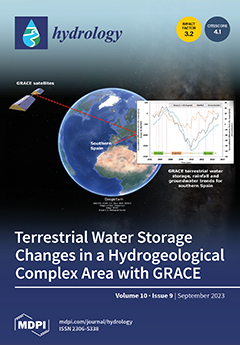The results from a four-year study of a freshwater pond on Long Island, NY, USA, do not point to a single source of boron (and by proxy other elements including nutrients) in this system. However, boron data from samples associated with this pond
[...] Read more.
The results from a four-year study of a freshwater pond on Long Island, NY, USA, do not point to a single source of boron (and by proxy other elements including nutrients) in this system. However, boron data from samples associated with this pond can be explained by mixing between average precipitation (weighted average
δ11B = 22.7) in the area and the local sources of boron, both natural and anthropogenic. This multiyear study provided the opportunity to see both yearly and seasonal differences. One algae sample from the pond showed significant fractionation and enrichment in light boron relative to the water and suggests algae may act as a boron sink. This type of biological fractionation could explain an observed down-gradient trend to heavier boron isotope values in pond water, which corresponds to the slight reduction in boron concentration seen in 2021. However, the trend was subdued in the following year, likely due to differences in the water flow rates and/or rate of algal growth. An opposite trend was seen with depth in the water, where δ
11B showed a positive correlation to boron concentration, which increased with depth from the surface of the pond. This gradient may be explained by the stratification of the pond with a heavy source concentrating in the bottom waters. The bottom water composition was consistent with goose feces (
δ11B = 25.8) or the addition of chemicals from the application of rock salt to local roads in winter. Surprisingly, boron from seawater (average
δ11B = 39.8) did not appear to have a direct impact on Setauket Pond, other than its influence on precipitation, providing heavy δ
11B and very low boron concentrations.
Full article





